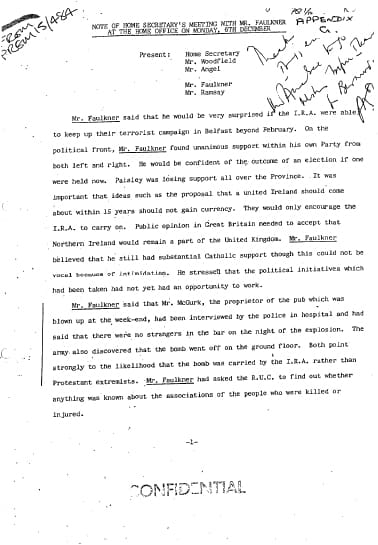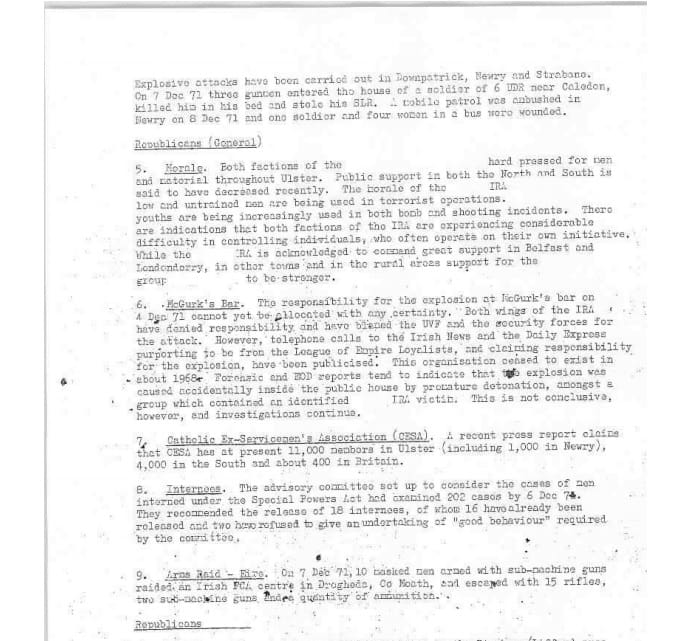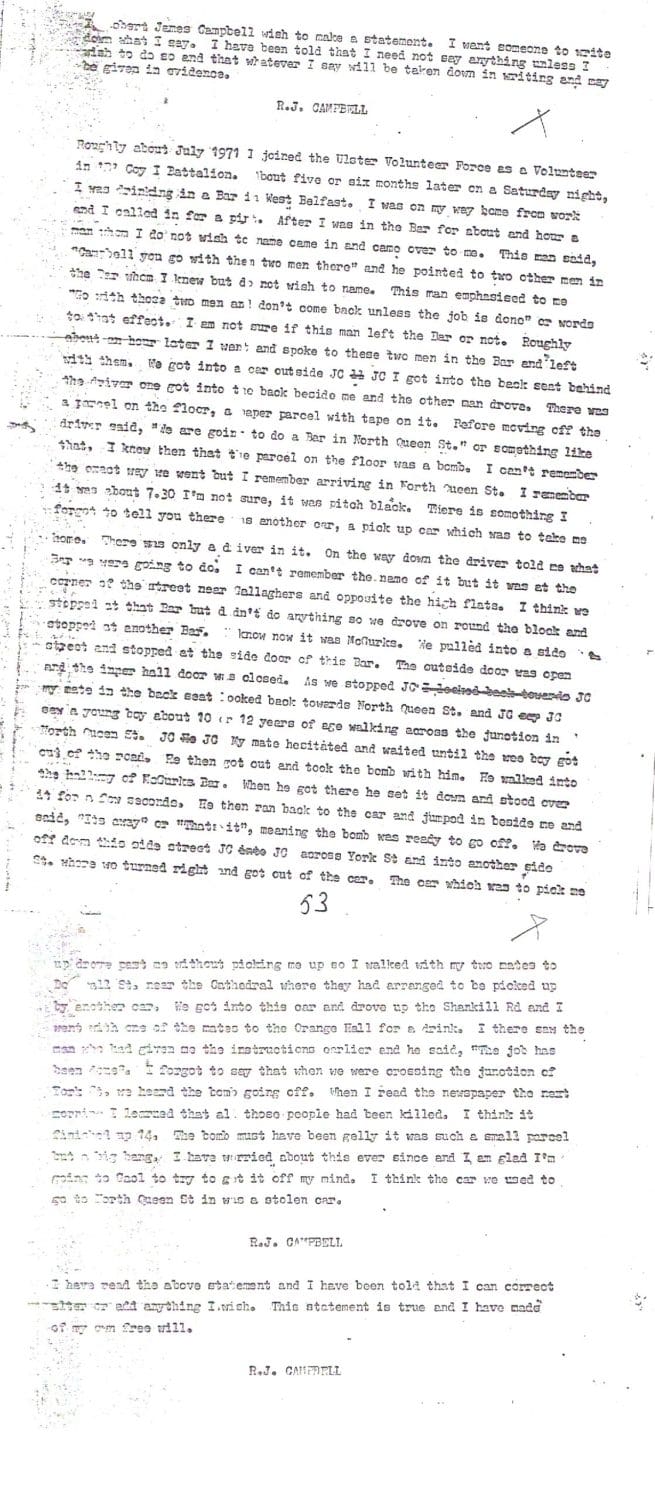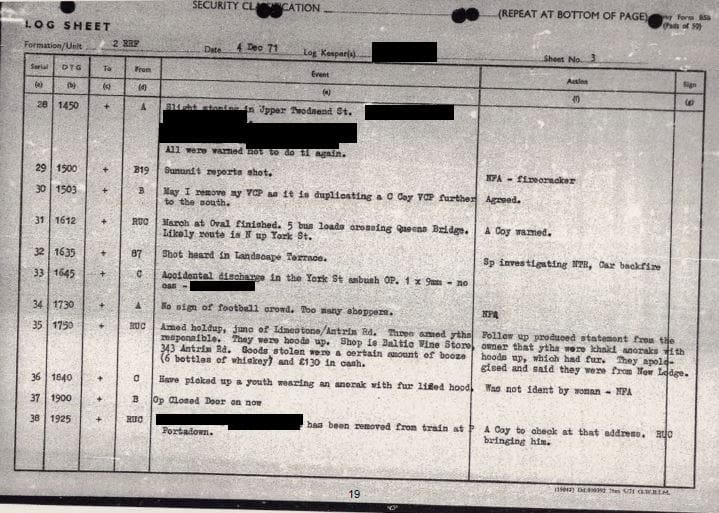On 4 December 1971, the Ulster Volunteer Force (UVF) blew up McGurk’s bar in Belfast killing 15 innocent people and injuring more than 16. The victims’ relatives and justice campaigners believe the British army and police have a lot more questions to answer about this attack. However, in 2011, the police ombudsman found “insufficient evidence” to prove there “was collusion on the part of the police.”
As the campaign for answers and justice continues, several uncovered documents support campaigners’ belief that there was collusion. Also, in an online seminar on 2 August, author and activist Ciarán MacAirt of Paper Trail revealed new information from files he’d uncovered at the national archive in Kew. MacAirt is a grandson of two McGurk’s bar victims.
MacAirt’s new files reveal the name of the UVF’s original target that evening and show there was a nearby British army presence that evening also. Moreover, MacAirt claims his revelations connect General Frank Kitson to the atrocity. This is why campaigners are demanding a new and independent investigation.
Initial British reaction to the bombing
Immediately after the bombing, authorities labelled it “an IRA own-goal”. British army officers told journalists the bar had been an IRA bomb training facility and this bomb had exploded prematurely. The police logged it as such in the duty officer’s report. This report claims:
Just before the explosion a man entered the licensed premises and left down a suitcase, presumably to be picked up by a known member of the Provisional I.R.A. The bomb was intended for use on other premises. Before the ‘pick-up’ was made the bomb exploded, 15 persons were killed and thirteen injured, 12 of whom were taken to hospital
This narrative would ensure the public blamed the IRA for the bombing and thereby help to drain it of local support. It would also criminalise the victims as bomb makers. But neither McGurk’s nor its customers were anything of the sort. It was a family pub in a Catholic part of north Belfast where neither customers nor staff were political.
And in any case, McGurk’s probably wasn’t even the UVF’s original target [click on ‘bomb run’ for this info] that December evening. The UVF didn’t care which bar it bombed. Because its intention was to murder and to create mayhem within the republican community, as documents uncovered by campaigners reveal.
Families and campaigners never believed the British version of events. To begin with, eight-year-old Joseph McClory claims that, on the night in question, he saw a man place the bomb in the porch of the pub. This contradicted the RUC’s [old name for the Police Service of Northern Ireland (PSNI)] story that claimed the bomb exploded [click on ‘breakthrough’] inside the bar.
Justice campaigns and revelations since 1971
The 30-year conflict in the north of Ireland ended in 1998. Yet a system that deals effectively with the killings during that conflict still doesn’t exist. In fact in 2001, the European Court of Human Rights found:
the inquest system in Northern Ireland did not provide sufficient safeguards to satisfy the procedural requirements of Article 2 [right to life]
So in September 2005, the PSNI launched the Historical Enquiries Team (HET) to examine unresolved deaths during the conflict. However, in 2013, the HET received criticism for examining cases involving the state in violent deaths with ‘less rigour’ than other cases. Victims’ families felt let down by this body.
In 2006, some of the McGurk’s victims’ families lodged a complaint with the Office of the Police Ombudsman for Northern Ireland (OPONI). They alleged: “the RUC had colluded in the attack; failed to conduct an effective investigation; and provided false information to government officials to suggest that it was an ‘IRA own-goal’”.
The OPONI reported to the families in July 2010, yet it found no evidence of police misconduct. However, as campaigners and NGOs found [footnote 141] inaccuracies and failures in that report, it was later withdrawn.
Families seek justice
But regardless of officialdom, families had been continuing their own fight for the truth. In 2009, campaigners uncovered an archive of documents that showed how the British had lied about the cause of the explosion. They discovered that bomb experts said the bomb was outside the main bar area and not inside as originally reported. Human rights group the Pat Finucane Centre (PFC) discovered the bombing cover-up went as high as then Northern Ireland prime minister Brian Faulkner.

Families also discovered that while military intelligence didn’t fully believe the IRA planted the bomb, it was nonetheless part of the cover-up. This is shown in the document below:
The responsibility for the explosion at McGurk’s bar on 4 December 71 cannot be allocated with any certainty.

But investigations undertaken by victims’ families were always fraught with difficulty. This was underlined in 2016 when some of the information they finally uncovered on military logs was restricted for a further 84 years.
Admission of guilt
Campaigners uncovered the July 1977 police statement from UVF member Robert James Campbell. In this one-and-a-half page statement, Campbell admitted his part in the bombing:

Campbell’s statement also reveals that McGurk’s wasn’t the UVF’s original target that evening. Campbell said:
I think we stopped at that bar but didn’t do anything so we drove on round the block and stopped at another bar. I know now it was McGurk’s
Paper Trail’s new revelations
MacAirt’s new evidence supports the idea that the original target of the bomb that evening was in fact the Gem Bar. The Canary spoke exclusively to MacAirt about this.
The document below includes face-to-face witness testimony given by an unnamed local to a British Army non-commissioned officer the morning after the attack:

It reads:
A person came up to an NCO [non-commissioned officer] with info re explosion was by pub for half hour, saw large dark car with white patch on left front side, noticed before explosion. Thinks bomb placed in off license entrance. Informant reckoned bomb was intended for Hanagans [sic] Bar [Hannigan’s Bar was the local name for the Gem Bar] which is on corner or North Queen St, [redacted] thinks maybe Brennans Bar junc North Queen St/Frederick St) Informant would not give name and has left.
The Gem bar had allegiances to the official republican movement which split from the Provisional IRA in 1969. So attacking it then blaming the IRA, would provoke tension between these two sides of Irish republicanism.
However, because there were men guarding outside [Click on ‘Bomb run’] the Gem bar, the UVF decided on a softer target. This would seal the fate of those inside McGurk’s.
MacAirt told The Canary:
This information proved to be correct and corroborated much of what we later learned from the newspaper boy eyewitness [Joseph McClory]. The British Ministry of Defence never made this corroborating testimony available to successive historic investigations or the families; or the historic investigations did know about it but chose to hide it.
Secret army unit
This partially redacted document of the British Army logs for the 2nd Battalion of the Royal Regiment of Fusiliers, shows that C Company reported to its headquarters at Glenravel – close to McGurk’s Bar – at 16:45. This was around 4 hours before the bomb. At Serial 33 it reads:
Accidental discharge in the York St ambush OP

According to MacAirt, previous historical investigations had denied the existence of any British military unit in the area. MacAirt added:
I have asked the British Ministry of Defence for further information about the deployment of this covert British military ambush OP as York Street intersected the area between the bomb explosion and the area in Little York Street where the bombers abandoned their car and may have overlooked both.
As the British Army planned an offensive ambush operation that night, that would explain a British military Out-of-Bounds (OOB) for the area as we have again long argued. What that covert operation was is obviously essential. Which British military unit manned it may be critical too. We may expect it was a unit of C Company 2 RRF but files, which I discovered and published, proved that the Military Reaction Force was leading a similar covert operation with 2 RRF the night before, close-by at the Mater Hospital.
Significance
MacAirt claims this evidence remained undiscovered or “buried” by previous historical investigations. So, this evidence will “therefore feature in future litigation against the British state”. He told The Canary that on the night and in the vicinity of the bombing there was:
British Army over-watch of the target area and there was a covert British military operation in the vicinity.
He claims:
The British Army logged the suspect cars before and after the explosion; that the RUC recovered and fingerprinted the car it considered was involved in the explosion – the records show that the RUC took 2 prints from that examination but again we never knew about this till 2011.
Furthermore, according to MacAirt:
The British Army and RUC knew where the seat of the explosion was – exactly in the place where the witness saw it planted – in the hallway, outside the bar – the original target, the Gem Bar, was indeed considered to be the most important OIRA [Official IRA – as opposed to the Provisional IRA] target in North Belfast…The files also prove that HQNI [British army – Headquarters Northern Ireland] connected the Gem as a target after the explosion at McGurk’s Bar – contrary to what we were told for nearly half a century.
Frank Kitson
MacAirt ends [23:48m] his online seminar by asking:
So, who lied and who created the McGurk’s Bar lie? What was its origin?
He continues:
At 1am, just over 4 hours after the attack and before all of the victims had been identified, including my own grandmother, the brigade commander informed his staff and headquarters Northern Ireland that the RUC have a line that the bomb in the pub was a bomb designed to be used elsewhere, left in the pub to be picked up by the Provisional IRA. Bomb went off and was a mistake. RUC press office have a line on it – NI should deal with them.
MacAirt claims this “was an egregious, heinous lie that attempted to criminalise innocent civilians”. He also claims the brigade commander “was the same person who had revamped the British military’s information and psyops units and had deployed the killer gang, the Military Reaction Force, onto the streets of Belfast.” MacAirt then claims this was the same person who, the day of the explosion, wrote:
It is likely that having fined down the enemy organisations to the extent we have done, future successes will be increasingly hard to achieve from an operational point of view, unless we are able to make our own organisation very much more efficient. As you know, we are taking steps to do this in terms of building and developing the MRF and we are steadily improving the capability of Special Branch.
According to MacAirt, the brigade commander was General Frank Kitson. Kitson served across the British Empire and finished up in Ireland. He was “a counterinsurgency theorist” and a commander in Belfast between 1970 and 1972.
What the families want
MacAirt told The Canary campaigners are demanding:
a new investigation which questions him [Kitson] under caution immediately and before he dies. His guilt and stature within the British military to this very day and the guilt of the RUC, tells you why the British state and the PSNI are fighting us tooth and nail in their attempts to stop us getting to the truth. It is taking time and at a tremendous physical and mental cost to the families. They [the British state] are failing. And we will prevail.
The Canary contacted the Police Service of Northern Ireland (PSNI). A spokesperson said:
As legal proceedings are ongoing, it would be inappropriate to comment at this time.
The Canary also contacted the Ministry of Defence (MoD) for comment. An MOD spokesperson said:
We have co-operated with a number of previous investigations into this incident. If anyone believes they have new information relating to potential criminality they should bring this to the attention of the Police Service of Northern Ireland.
As the bombing of McGurk’s Bar is the subject of ongoing legal claims it would not be appropriate for us to comment further at this time.
The Canary also contacted the Northern Ireland Office for comment but it did not respond. The Canary made all possible efforts to obtain a specific comment relating to the allegations made against General Frank Kitson. Eventually, another MoD spokesperson referred us back to the same statement:
We have co-operated with a number of previous investigations into this incident. If anyone believes they have new information relating to potential criminality they should bring this to the attention of the Police Service of Northern Ireland.
As the bombing of McGurk’s Bar is the subject of ongoing legal claims it would not be appropriate for us to comment further at this time.
A legacy of peace?
MacAirt’s revelations come as we mark 49 years since the British imposed internment on the north of Ireland. This was a regime that predominantly interned people from a Catholic or Irish republican background. It started just four months before the UVF bombed McGurk’s.
And his revelations come at a time when we mourn the passing of political activist and Nobel peace prize winner John Hume. In the wake of Hume’s death, commentators lavished him with praise for his “quest for peace” in the north of Ireland. They called him a “peacemaker”.
But without such atrocities, the need for a peacemaker may not have been as pressing. Because tragically, campaigners’ allegations of collusion in the McGurk’s case are far from isolated. Today the British state can begin to put that right with a fully independent inquiry into what happened that December evening in 1971.
Featured image via Pixabay / YouTube – AP Archive
















